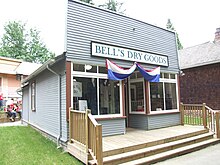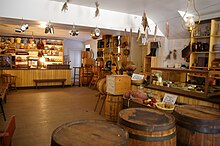Dry goods


Dry goods is a historic term describing the type of product line a store carries, which differs by region. The term comes from the textile trade, and the shops appear to have spread with the mercantile trade across the British Empire (and former British territories) as a means of bringing supplies and manufactured goods to far-flung settlements and homesteads. Starting in the mid-18th century, these stores began by selling supplies and textile goods to remote communities, and many customized the products they carried to the area's needs. This continued to be the trend well into the early 20th century. With the rise of department stores and catalog sales, the decline of dry goods stores began, and the term has largely fallen out of use. Some dry goods stores became department stores especially around the turn of the 20th century.
The term goes back to the 17th century and originally referred to any goods measured in dry measure, not liquid measure, of volume, such as stere, bushel or peck. Dry goods as a term for textiles dates back to 1742 in England[1] or even a century earlier.[2]
Commonwealth and Philippines usage
[edit]
In Commonwealth countries and the Philippines, dry goods are dry (dried, preserved) food items which have a years-long or indefinite shelf-life. They are "dry" because they are not stored in a preserving anti-fungal or anti-bacterial liquid which fully wets the preserved goods. The "dry goods" usage is made with reference to pre-refrigeration days of the early 20th century. Such foods could be transported and stored without immediate danger of spoiling, and without the extra weight and fragility of waterproof glass or ceramic containers.[3] Dried beans, flours, whole grains, and rolled oats are examples of this type of dry goods.[4]
U.S. usage
[edit]
In the United States, dry goods are products such as textiles, ready-to-wear clothing, toiletries,[1] and "grocery items (such as tobacco, sugar, flour, and coffee) that do not contain liquid."[2] In US retailing, a dry-goods store carries consumer goods that are distinct from those carried by hardware stores and grocery stores.[1] Downtown Ann Arbor, Michigan had as many as 15 stores that sold dry goods.[5]

Dry goods can be carried by stores specializing only in those products (a type of specialty store), or may be carried by a general store or a department store.[6]
‘Dry goods’ is the collective name of textile fabrics and manufactured articles.[1] In the late 1800s there were hundreds and thousands of dry goods wholesaling stores and retail stores in America throughout towns and villages, engaging over one million people into the industry of dry goods trades.[1]
Beginning in the early 20th century, many dry goods stores expanded into other lines of merchandise, and the term largely disappeared from both everyday usage and the official names of the businesses concerned. As an example, The Denver Dry Goods Company became known to a generation simply as The Denver, a mall anchor store in the western United States.[7]
See also
[edit]References
[edit]- ^ a b c d e Cole, George S. (1892). "Dry Goods". A Complete Dictionary of Dry Goods. Chicago: W. B. Conkey Company. 19th-century book about fabrics.
- ^ a b "dry goods". Merriam-Webster. Retrieved July 21, 2020.
- ^ "dry goods Meaning". dictionary.cambridge.org.
- ^ Dry Goods Economist. J. Mackey. 1917.
- ^ Dry goods Historical Marker data base.
- ^ "Retail middlemen of consumer goods". marketing-howto.com. Archived from the original on 2008-09-24.
- ^ ""The Elegant Things Have Vanished": Dining at The Denver Dry Goods' Tearoom | History Colorado". www.historycolorado.org. 1 Oct 2015. Archived from the original on 8 May 2021. Retrieved 8 May 2021.
In 1966, the Denver trimmed the Dry Goods from its name for the sake of keeping up with the pace of the go-go decade. Known as "The Denver," management added stores along the Front Range and in Montana over the next decade.
External links
[edit] Media related to Dry goods at Wikimedia Commons
Media related to Dry goods at Wikimedia Commons
